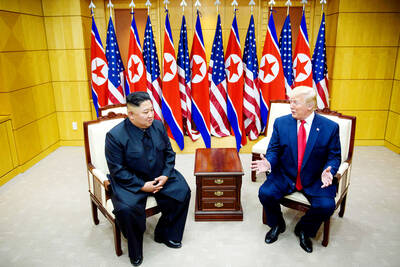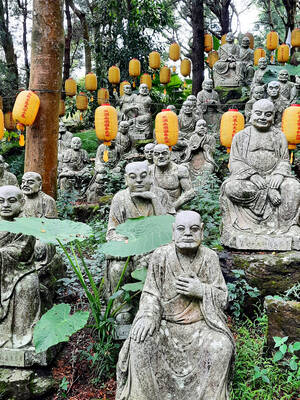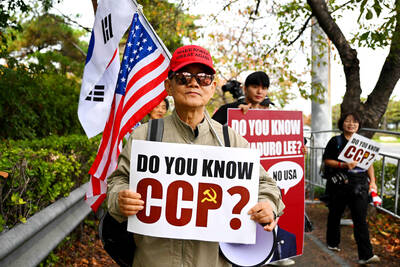“There they are!” exclaimed Howard G. Buffett, the Illinois corn farmer, philanthropist and down-home son of one of the world’s richest men, as he steered his dusty Toyota Land Cruiser toward a pair of nature’s fastest and most majestic creatures.
Orion and Titan — cheetahs bought at US$2,000 apiece for the cheetah conservation reserve Buffett established here — sat smack in the middle of the dirt road. They licked each other’s faces and ambled languorously into the bush. Then one of them scented prey. His elegant body elongated into a tensile creep, the tip of his tail twitching.
“He’s on to something,” Buffett whispered. “Look how he’s moving.”
The cheetah’s crouch became a lope, but he pulled up suddenly at an electrified fence that keeps him from straying onto the adjoining game hunting farm. The ungainly ostrich he was stalking stood on the other side, blinking stolidly at the bewildered cat.
“You idiot!” Buffett said with a hearty guffaw. “You thought you could get that!”
Despite his affection for Orion and Titan, Buffett’s recent drive through the Jubatus Cheetah Reserve is likely to be among his last. He has decided to sell the 2,428-hectare of bush in Limpopo province, along with the rhinos, giraffes and zebras that ramble through it. He will try to relocate the cheetahs.
The reserve was his original philanthropic stake in Africa and his most sizable commitment to animal conservation. Once it is gone, he will complete his evolution from a man galvanized by an enthusiasm for cheetahs, polar bears and mountain gorillas to one consumed by a desire to help the poorest people: African farm families, starving children and victims of conflict.
The making of this accidental philanthropist — the accidental part being his birth as the son of the legendary investor Warren E. Buffett — is an American tale of wealth and conscience passed on to a second generation. The elder Buffett, 79, did not believe in giving his money to his children to spend on themselves, but decades ago he did begin preparing them to give some of it away.
When Buffett, now 54, was in his early 30s, his father set up a foundation so each of his children could give away US$100,000 a year. Howard, who grew up watching Mutual of Omaha’s Wild Kingdom, now calls this “the small money” — he used it to support a bear rehabilitation center and mountain lion research, among other things.
Then a decade ago, as the family sat around a Christmas tree, Warren and Susan Buffett told their children they were giving each of them US$35 million to donate to the causes of their choice. “Go and do good things,” Howard recalls his father telling them. The son said his father had gently challenged him at times about his focus on conservation, but never told him how to spend the money.
It was not until 2006, after his wife’s death in 2004, that the elder Buffett announced that he was giving away the bulk of his fortune, US$31 billion, to the foundation set up by Bill and Melinda Gates. But he also committed about US$1 billion worth of stock to each of his children for charitable giving.
Asked if he resented the huge gift to the Gates foundation, Buffett said, “I’m not going down that road,” and let loose with a belly laugh.
Buffett’s engagement with Africa began serendipitously in the late 1990s, when he began coming to South Africa on business as a partner in a company that sold grain silos. Back home, flipping through television channels, he caught a program on cheetahs. “I’m watching the credits and I see it’s in South Africa,” he said.
He then embarked on a decade of work to build a reserve that aimed to be a center of cheetah research and conservation, but said the results had been disappointing. He said he had hoped to establish that cheetahs could thrive on small private reserves without depleting expensive game stocks. But he found that the cats killed for sport, even when they were so stuffed from feasting on prey that they practically waddled. And the research did not take off. A state-of-the-art laboratory on the reserve sits unused.
“There are a lot of politics, a lot of turf, a lot of egos, and I think also part of it was that I’m an outsider,” he said.
But Buffett’s connection to the dun-and-olive landscape of Limpopo has become part of the campaign against hunger his foundation is engaged in across Africa. It has paid for 3,723 hectares of farmland not far from the cheetah reserve. Plant researchers there are now developing drought-tolerant varieties of maize.
And Buffett, who spends so much time in South Africa that he has permanent residency, is driving one of those auto-steer tractors he loves into the fields, planting crops that he hopes will yield improved seeds for African farmers.
A Republican and a farmer, he has a maverick take on the continent’s agricultural challenges — for example, he is a skeptic about subsidies for seed and fertilizer. In recent years, his foundation, which accepts no unsolicited proposals, has added ambitious projects related to clean water and increased farm productivity.
But so far Buffett’s approach has not reached a broad audience. His foundation has no Web site and a staff of only eight. And he does not go to conferences where experts debate policy.
“I don’t see him and his ideas out there very much,” said Julie Howard, executive director of the Washington-based Partnership to Cut Hunger and Poverty in Africa. “He’s not reclusive, but he’s a kind of to-the-ground person.”

US President Donald Trump may have hoped for an impromptu talk with his old friend Kim Jong-un during a recent trip to Asia, but analysts say the increasingly emboldened North Korean despot had few good reasons to join the photo-op. Trump sent repeated overtures to Kim during his barnstorming tour of Asia, saying he was “100 percent” open to a meeting and even bucking decades of US policy by conceding that North Korea was “sort of a nuclear power.” But Pyongyang kept mum on the invitation, instead firing off missiles and sending its foreign minister to Russia and Belarus, with whom it

When Taiwan was battered by storms this summer, the only crumb of comfort I could take was knowing that some advice I’d drafted several weeks earlier had been correct. Regarding the Southern Cross-Island Highway (南橫公路), a spectacular high-elevation route connecting Taiwan’s southwest with the country’s southeast, I’d written: “The precarious existence of this road cannot be overstated; those hoping to drive or ride all the way across should have a backup plan.” As this article was going to press, the middle section of the highway, between Meishankou (梅山口) in Kaohsiung and Siangyang (向陽) in Taitung County, was still closed to outsiders

Many people noticed the flood of pro-China propaganda across a number of venues in recent weeks that looks like a coordinated assault on US Taiwan policy. It does look like an effort intended to influence the US before the meeting between US President Donald Trump and Chinese dictator Xi Jinping (習近平) over the weekend. Jennifer Kavanagh’s piece in the New York Times in September appears to be the opening strike of the current campaign. She followed up last week in the Lowy Interpreter, blaming the US for causing the PRC to escalate in the Philippines and Taiwan, saying that as

The Chinese Communist Party (CCP) has a dystopian, radical and dangerous conception of itself. Few are aware of this very fundamental difference between how they view power and how the rest of the world does. Even those of us who have lived in China sometimes fall back into the trap of viewing it through the lens of the power relationships common throughout the rest of the world, instead of understanding the CCP as it conceives of itself. Broadly speaking, the concepts of the people, race, culture, civilization, nation, government and religion are separate, though often overlapping and intertwined. A government